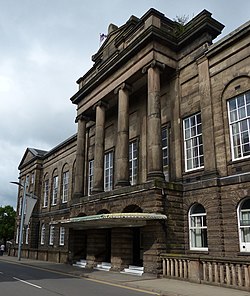| Stoke-on-Trent Town Hall | |
|---|---|
 Stoke-on-Trent Town Hall | |
| Location | Glebe Street, Stoke-on-Trent |
| Coordinates | 53°00′17″N 2°10′55″W / 53.0047°N 2.1820°W |
| Built | 1834 |
| Architect | Henry Ward |
| Architectural style(s) | Neoclassical style |
Listed Building – Grade II | |
| Official name | Jubilee Hall Kings Hall Town Hall |
| Designated | 19 April 1972 |
| Reference no. | 1297959 |
Stoke-on-Trent Town Hall is a municipal building in Glebe Street, Stoke-on-Trent, Staffordshire, England. The town hall, which is the meeting place of Stoke-on-Trent City Council, is a Grade II listed building.[1]
History
The first town hall in Stoke-on-Trent was erected in the Market Place between Market Street (now known as Hill Street) and Hide Street in 1794: it had arcading on the ground floor to allow markets to be held and an assembly room was established on the first floor.[2][3] After significant industrial growth in the early 19th century, particularly associated with the potteries industry, civic leaders decided to procure a larger structure: the site selected was north east of the original structure in the heart of the potteries manufacturing area.[4][a]
The new building was designed by Henry Ward in the neoclassical style, built in rusticated stone on the ground floor and ashlar stone above and was completed in 1834.[1] The design originally involved a symmetrical main frontage with just three bays facing onto the Glebe Street; it featured a large portico with three archways on the ground floor beneath four Ionic order columns supporting an entablature and a pediment.[1] It was extended with a north wing for use by the police in 1842 and a south wing for use by the courts in around 1850.[1] The outer bays in each of the two wings were slightly projected forward, enhanced with Ionic order pilasters on the first floor and pedimented as pavilions.[1] Internally, the principal room was a market hall in the centre of the building,[7] but the ground floor was remodelled in 1888 to convert the market hall into a public hall and to create a council chamber, a mayor's parlour and some municipal offices.[8]
Assembly rooms known as the King's Hall and the Jubilee Hall were constructed to a design by Thomas Wallis and James Albert Bowden behind the main structure in 1911.[1][9] The town hall became the headquarters of the new county borough of Stoke-on-Trent in 1910 and King George V and Queen Mary visited the town hall and announced the town's advancement to city status on 5 June 1925.[10] The rock band, the Beatles, performed at a concert in the King's Hall on 26 January 1963.[11] The building remained the local seat of government after the formation of the enlarged Stoke-on-Trent City Council in 1974.[12]
The new city council inherited additional facilities at Unity House in Hanley which had been completed in 1973, but as part of an initiative to co-locate its staff, the city council vacated Unity House and constructed a civic centre to the immediate north of the town hall in 1992.[13] In 2012 the city council announced its intention to relocate some of its staff back to Hanley but into a newly built facility there.[14][15] After a programme of refurbishment works costing £1.5 million was completed in 2018, the register office moved from Hanley Town Hall into the newly-refurbished building in October 2020.[16]
Notes
- ^ The first town hall was subsequently used as a fire station and then as a drill hall before being demolished just before the Second World War; the site is now occupied by a car park.[5][6]
References
- ^ a b c d e f Historic England. "Jubilee Hall Kings Hall Town Hall (1297959)". National Heritage List for England. Retrieved 29 January 2021.
- ^ "First Town Hall, Stoke". Potteries Heritage Society. Retrieved 29 January 2021.
- ^ Jenkins, J. G. (1963). "'Stoke-upon-Trent: Local government, economic history and social life', in A History of the County of Stafford". London: British History Online. pp. 194–205. Retrieved 29 January 2021.
- ^ "Ordnance Survey Map". 1882. Retrieved 29 January 2021.
- ^ "Work starts on site of Stoke-on-Trent's first town hall". BBC. 5 December 2020. Retrieved 29 January 2021.
- ^ "New 74-space pay-and-display car park to open in this Stoke-on-Trent town centre". BBC. 5 December 2020. Retrieved 29 January 2021.
- ^ "Stoke Town Hall, Glebe Street, Stoke". Staffordshire County Council. Retrieved 29 January 2021.
- ^ "Stoke Town Hall". Potteries Heritage Society. Retrieved 29 January 2021.
- ^ Skinner, Joan (1997). Form and Fancy: Factories and Factory Buildings by Wallis, Gilbert and Partners, 1916-39. Liverpool University Press. p. 10. ISBN 978-0853236221.
- ^ "King George V and Queen Mary visit Stoke-on-Trent". Mace Archive. 5 June 1925. Retrieved 29 January 2021.
- ^ "The top 18 most haunted places in North Staffordshire including Trentham Gardens, Alton Towers and Burslem". Stoke Sentinel. 7 October 2019. Retrieved 29 January 2021.
- ^ Local Government Act 1972. 1972 c.70. The Stationery Office Ltd. 1997. ISBN 0-10-547072-4.
- ^ "Freedom of Information Request: Cost of Civic Centre Stoke". Stoke-on-Trent City Council. 21 June 2013. Retrieved 29 January 2021.
- ^ "Stoke-on-Trent City Council scraps Civic Centre sale". BBC. 22 October 2013. Retrieved 29 January 2021.
- ^ "New £45m Stoke-on-Trent council house not 'satisfactory'". BBC. 5 May 2015. Retrieved 29 January 2021.
- ^ "Registrars service to move to Stoke Town Hall". North Staffs TV. 6 January 2020. Retrieved 16 April 2022.

